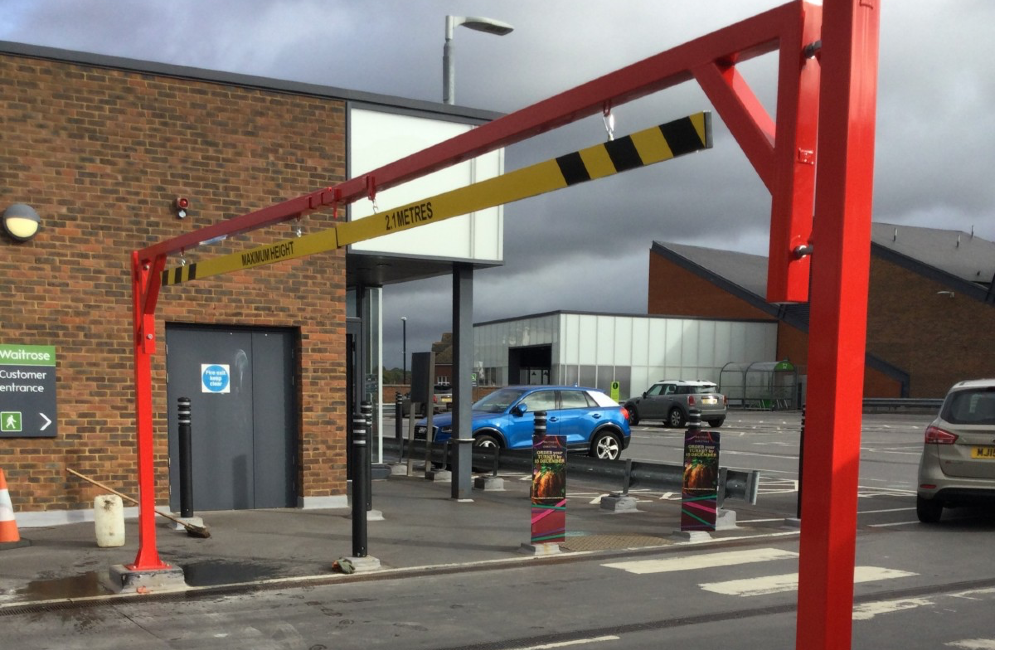Large Stock Available
Domestic & Commercial
Installation Within 10 Days
Quality
Of Work
Parking Security
Price Match Guarantee
How to manage HGV access with one double leaf height restrictor

If you manage a site that needs to control the entry of large vehicles, one of the most effective ways to do it involves the use of a double leaf height restriction barrier. Essentially, it enables you to admit the right HGVs to your site, while blocking access to any vehicles that don’t meet your site’s requirements. Before you make your decision as to exactly which one you need though, you’ll need to plan for installation, day-to-day use, and any potential problems that could come up.
That’s where we can help here at Bollard Security. We have over 15 years of experience in supplying double leaf height restrictors alongside a wide range of commercial bollards, and we’re trusted by site managers all over the country to provide durable solutions that maximise the safety, security and convenience of access control. We also make sure you get the very best prices, so you can strengthen your access control without putting extra strain on your budget. So, when it comes to double leaf height restrictors, here’s what you need to know!
3 key factors you need to assess before installation
Before you install a double leaf height restrictor, there are several considerations that you’ll need to take into account. Some may be specific to your individual site, but broadly speaking, the most universal ones include:
- Site layout and approach routes
- Vehicle types and clearance needs
- Integration with existing security systems
So, to look at those in a bit more detail:
You’ll need to assess how your site is laid out before you install a double leaf height restrictor. For example, think about how much space you have at the entry and whether the vehicles that use it have the clearance to turn, align, and move safely. The restrictor needs to be positioned so that it gives drivers clear visibility of the limit, and avoids any risk of damage to trailers, cabs, or surrounding property. You’ll also need to assess the approach route that HGVs will need to take as they enter your site, so that you can avoid the risk of any difficult manoeuvring, delays or accidents.
You’ll also need to consider the type of vehicles you’ll admit. Some sites deal only with articulated lorries while others also need to accommodate vans, plant machinery, or specialist vehicles. Your restrictor needs to match the range of vehicles you expect, otherwise it’s easy to accidentally create bottlenecks.
Finally, you’ll need to plan how the restrictor integrates with your site’s wider security or access control system. If you already have barriers, bollards, or gates, the double leaf restrictor should work as part of that setup. For example, you might want the restrictor to create a pre-screening point where only approved vehicles are directed towards the main gate. Alternatively, you might need it to provide a secondary level of control alongside bollards that regulate pedestrian access.
4 vital requirements for safe and effective operation
Once your double leaf height restrictor has been installed, there are a couple of key elements it’s useful to consider in order to maximise the smoothness of its operation, and protection for both people and vehicles. These include:
Regular inspections
This almost goes without saying, but we’ll say it anyway – you’ll need to check the restrictor on a routine basis. Hinges, locking points, and support posts can take strain every time a vehicle passes through, and exposure to rain, wind, and temperature changes can inflict their own gradual wear and tear too. Regular inspections can be enormously useful in helping you to spot wear before it turns into a hazard. They also give you a chance to schedule maintenance at a time that won’t disrupt site operations.
Driver communication
You’ll need clear communication so that HGV drivers can approach and pass through without unnecessary risk. Any signs will need to be positioned well in advance of the restrictor, with clear height limits displayed in large print. This gives drivers enough warning to slow down and line up correctly. You’ll also want staff trained to step in and guide unfamiliar drivers if necessary, which can help to reduce the chance of misjudgement and impact.
Staff training
You’ll also need your (authorised) staff to know exactly how to operate the restrictor. That means training them to open, close, and lock it properly every time. They’ll also need to recognise the early signs of wear or damage, such as unusual resistance in hinges or bolts loosening. All that can help to cut down on the risk of mistakes, and ensure that issues are dealt with before they become serious.
Clear access areas
You’ll need to make sure the ground around the restrictor remains clear. Large HGVs need space to swing into alignment, and clutter in the approach zone can force drivers into awkward or unsafe manoeuvres. Common types of “clutter” in this context by the way includes parked cars, stored pallets, or waste containers, so it’s worth trying to make sure that your premises is as free from these as you reasonably can.
A quick look at the most common pitfalls to avoid
As we’ve covered above, a double leaf height restrictor can provide a wide range of benefits to your premises, but in order to get the best out of them it’s always a good idea to pay particular attention to the major pitfalls to avoid when installing them. These can often arise when the role of the restrictor within the wider access system hasn’t been fully thought through, or when assumptions are made about how drivers will interact with it in practice. One of the best ways to avoid mistakes is to map how vehicles approach, queue, and exit in detail, all of which can help you avoid disruption later.
One common mistake involves underestimating how much clearance HGVs need when they enter or exit. If a restrictor is installed and the turning circles haven’t been measured properly, that can create a choke point that frustrates drivers and slows your operations. It’s also important not to neglect planning for peak traffic periods. If several HGVs end up arriving at the same time, a restrictor that’s slow or awkward to use will create queues, which can affect the wider operations of your site.
And of course, poor upkeep is something you’ll really want to avoid. Without checks, bolts can loosen, paint can deteriorate, and moving parts can stiffen. As well as creating safety risks, this increases long-term costs when the equipment eventually fails. Finally, you’ll want to ensure that consideration has been given to how the restrictor fits into a site’s traffic management plan. If a restrictor isn’t linked with other access points, signage, or flow systems, the result can be confusion for drivers and unnecessary strain on your staff.
Those are the key points in a nutshell! If you have any more specific questions about our height restriction barriers, feel free to ask our team here at Bollard Security – throughout our 15 years in business, we’ve always taken pride in installing and maintaining security solutions across the UK for domestic, commercial, and industrial sectors, and we take pride in providing quality products that give our customers peace of mind. Don’t hesitate to contact us on 01535 509001 for advice and recommendations on the best height restriction barriers or other commercial access control solutions for your site – we’re always happy to help.


